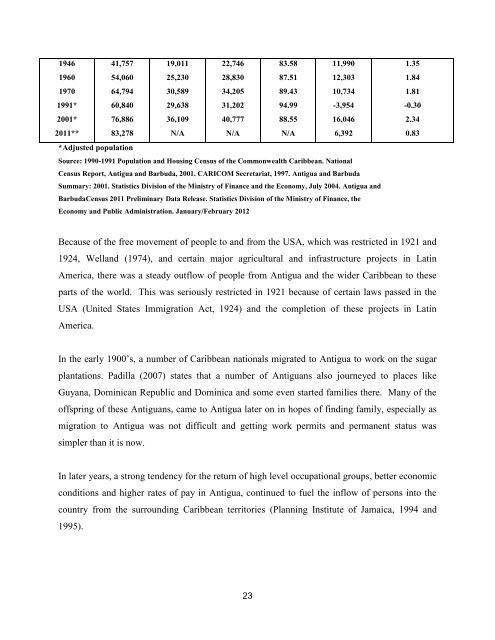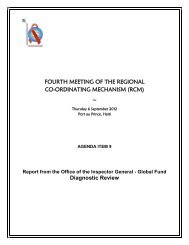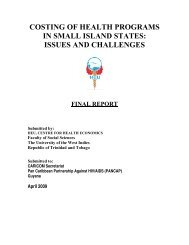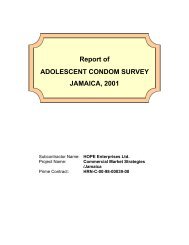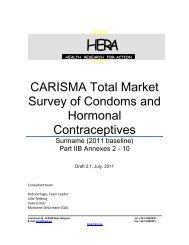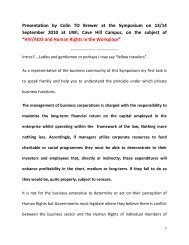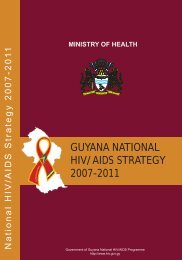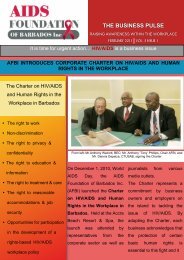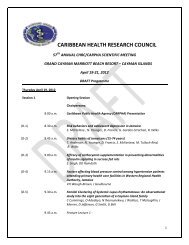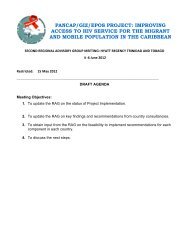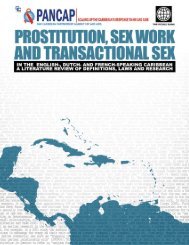Access to HIV Services for Mobile and Migrant Populations in Antigua
Access to HIV Services for Mobile and Migrant Populations in Antigua
Access to HIV Services for Mobile and Migrant Populations in Antigua
Create successful ePaper yourself
Turn your PDF publications into a flip-book with our unique Google optimized e-Paper software.
1946<br />
1960<br />
1970<br />
1991*<br />
2001*<br />
2011**<br />
41,757<br />
54,060<br />
64,794<br />
60,840<br />
76,886<br />
83,278<br />
19,011<br />
25,230<br />
30,589<br />
29,638<br />
36,109<br />
N/A<br />
22,746<br />
28,830<br />
34,205<br />
31,202<br />
40,777<br />
N/A<br />
83.58<br />
87.51<br />
89.43<br />
94.99<br />
88.55<br />
N/A<br />
11,990<br />
12,303<br />
10,734<br />
-3,954<br />
16,046<br />
6,392<br />
*Adjusted population<br />
Source: 1990-1991 Population <strong>and</strong> Hous<strong>in</strong>g Census of the Commonwealth Caribbean. National<br />
Census Report, <strong>Antigua</strong> <strong>and</strong> Barbuda, 2001. CARICOM Secretariat, 1997. <strong>Antigua</strong> <strong>and</strong> Barbuda<br />
Summary: 2001. Statistics Division of the M<strong>in</strong>istry of F<strong>in</strong>ance <strong>and</strong> the Economy, July 2004. <strong>Antigua</strong> <strong>and</strong><br />
BarbudaCensus 2011 Prelim<strong>in</strong>ary Data Release. Statistics Division of the M<strong>in</strong>istry of F<strong>in</strong>ance, the<br />
Economy <strong>and</strong> Public Adm<strong>in</strong>istration. January/February 2012<br />
1.35<br />
1.84<br />
1.81<br />
-0.30<br />
2.34<br />
0.83<br />
Because of the free movement of people <strong>to</strong> <strong>and</strong> from the USA, which was restricted <strong>in</strong> 1921 <strong>and</strong><br />
1924, Well<strong>and</strong> (1974), <strong>and</strong> certa<strong>in</strong> major agricultural <strong>and</strong> <strong>in</strong>frastructure projects <strong>in</strong> Lat<strong>in</strong><br />
America, there was a steady outflow of people from <strong>Antigua</strong> <strong>and</strong> the wider Caribbean <strong>to</strong> these<br />
parts of the world. This was seriously restricted <strong>in</strong> 1921 because of certa<strong>in</strong> laws passed <strong>in</strong> the<br />
USA (United States Immigration Act, 1924) <strong>and</strong> the completion of these projects <strong>in</strong> Lat<strong>in</strong><br />
America.<br />
In the early 1900’s, a number of Caribbean nationals migrated <strong>to</strong> <strong>Antigua</strong> <strong>to</strong> work on the sugar<br />
plantations. Padilla (2007) states that a number of <strong>Antigua</strong>ns also journeyed <strong>to</strong> places like<br />
Guyana, Dom<strong>in</strong>ican Republic <strong>and</strong> Dom<strong>in</strong>ica <strong>and</strong> some even started families there. Many of the<br />
offspr<strong>in</strong>g of these <strong>Antigua</strong>ns, came <strong>to</strong> <strong>Antigua</strong> later on <strong>in</strong> hopes of f<strong>in</strong>d<strong>in</strong>g family, especially as<br />
migration <strong>to</strong> <strong>Antigua</strong> was not difficult <strong>and</strong> gett<strong>in</strong>g work permits <strong>and</strong> permanent status was<br />
simpler than it is now.<br />
In later years, a strong tendency <strong>for</strong> the return of high level occupational groups, better economic<br />
conditions <strong>and</strong> higher rates of pay <strong>in</strong> <strong>Antigua</strong>, cont<strong>in</strong>ued <strong>to</strong> fuel the <strong>in</strong>flow of persons <strong>in</strong><strong>to</strong> the<br />
country from the surround<strong>in</strong>g Caribbean terri<strong>to</strong>ries (Plann<strong>in</strong>g Institute of Jamaica, 1994 <strong>and</strong><br />
1995).<br />
23


